Ecology Final
1/81
There's no tags or description
Looks like no tags are added yet.
Name | Mastery | Learn | Test | Matching | Spaced |
|---|
No study sessions yet.
82 Terms
Facilitation (Definition and Example)
Facilitation is when one species helps another succeed, but it’s a broad, non-species specific kind of help. It’s not a close relationship — just one species making life easier for another.
Not mutualism–can be one way
Facilitation = "Anyone can help."
Example: Plants stabilizing soil or shading each other. Facilitation is basically happening everywhere in nature.
Facilitative Mutualism (Definition and Example)
Facultative mutualism is a species-specific partnership where both species benefit, but they don’t absolutely need each other to survive. It’s like an optional teamwork boost.
Facultative = "Specific help, but optional."
Example: Cowbirds and bison — bison stir up insects for cowbirds to eat, and cowbirds reduce pests that bother bison, making it a two-way facultative mutualism.
Obligate Mutualism (Definition and Example)
Obligate mutualism is when two species are in such a species-specific, tight relationship that they depend on each other to survive — no choice.
Obligate = "Specific help, and mandatory."
Examples:
Yucca and yucca moth — each can’t reproduce without the other.
Endosymbiotic theory — how mitochondria and chloroplasts came from ancient mutualisms between prokaryotic cells.
Human microbiome — humans provide the microbiome with food and shelter, and in return, the microbiome helps with digestion, immunity, and health.
What is the stress-gradient hypothesis, and when are facilitation and mutualisms most important?
In high-stress environments (drought, heat, poor soil), species struggle to survive alone.
Helping each other boosts survival (e.g., sharing resources, stabilizing habitat).
Competing would make survival even harder, so positive interactions are favored.
In low-stress environments, survival is easy, so competition dominates as species fight for more.
What is endosymbiotic theory and give an example?
Endosymbiotic Theory
The endosymbiotic theory says that eukaryotic cells (like plant and animal cells) evolved when one prokaryotic cell lived inside another in a mutualistic relationship.
Over time, these internalized cells became permanent parts of the host cell — forming organelles like mitochondria and chloroplasts.
Example:
Mitochondria (responsible for energy production) and chloroplasts (responsible for photosynthesis) were originally free-living prokaryotes that became part of larger cells through mutualism.
Protection Mutualism
One species provides protection (from predators, herbivores, parasites) in exchange for some reward.
Example:
Ant-plant mutualism — plants produce extrafloral nectar to attract ants, and ants protect the plant from herbivores.
Transport Mutualism (definition and example)
A mobile species moves gametes (like pollen) or individuals (like seeds) for a sessile species (does not move) and gets a reward.
Example:
Pollinators moving pollen between plants.
Nutrient Mutualism
Two species exchange nutrients or help each other access nutrients.
Examples:
Coral and algae — coral gets carbon food from algae, algae get organic waste from coral.
Mycorrhizal fungi and plants — fungi increase root surface area to help plants get water and nutrients (like phosphorus); plants feed fungi with sugars.
What are mycorrhizae and why are they important?
Mycorrhizae = Mutualism between fungi and plant roots.
Fungi increase root surface area → help plants absorb more water and nutrients (especially phosphorus).
Plants feed fungi with sugars (root exudates).
Important because they boost plant survival and growth, especially in stressful environments.
When do mutualistic relationships evolve? What are some examples with humans?
Mutualisms evolve when the benefits outweigh the costs and increase the fitness of both species.
Species aren’t "trying" to help — they cooperate because it boosts survival and reproduction.
Examples with humans:
Microbiome (bacteria and fungi help digestion, immunity).
Mitochondria (energy-producing organelles from ancient mutualistic bacteria).
Explain the Palmer et al. study (ants, trees, elephants):
Why do 4 ants coexist on the same tree?
Why aren't mutualisms static?
What happened when elephants were excluded?
Four different ant species coexist on the same Acacia trees by occupying different niches based on tree age, size, or condition (resource partitioning).
Mutualisms aren’t static because environmental conditions change — species optimize their own fitness, not the relationship itself.
Without elephants, trees grew bigger, became less vulnerable, evolved to reduce rewards (like nectar and domatia), and ants defended less.
Trees evolved to invest in ants when vulnerable, and save energy by reducing rewards when they no longer needed protection.
No elephants = no need for bodyguards = no paycheck = ants quit
What do positive interactions or mutualisms do to a species' realized niche?
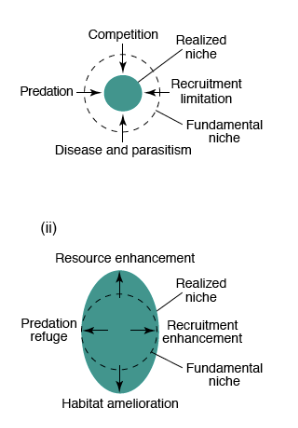
Realized niche = the actual conditions and places where a species lives and survives after factoring in competition, predation, and disease (real-world limits).
Positive interactions and mutualisms can expand the realized niche, helping species overcome these limits.
This expansion is strongest in high-stress environments, where species need help to survive.
Stressful world = bigger niche with friends.
Diagram:
Without help = niche shrinks.
With help = niche expands.
What are critiques of the "overly optimistic" view that nature is collaborative? How should we view symbiosis like trees and fungi?
Mutualisms happen only when they increase fitness, not out of kindness.
Species cooperate to maximize their own benefits — not to "help" others.
Mutualisms have costs and can break down if benefits disappear.
Better view: Symbiosis is a reciprocal exchange, like a business deal, not altruism.
What is Coexistence?
Definition:
Long-term survival of two or more species together without one driving the other extinct.Key Idea:
Species balance competition, predation, or other interactions in ways that allow them all to persist.Example:
Prey survive alongside predators by using refuges (safe spaces) or predator satiation (overwhelming numbers).
Compare ecological dynamics, evolutionary dynamics, and coexistence.
Ecological dynamics:
Short-term changes in behavior or trait expression based on current conditions — no genetic change yet.
(Example: Trees grow more spines and feed more ants when elephants are present.)Evolutionary dynamics:
Long-term genetic changes over many generations through natural selection.
(Example: Trees evolve to always have bigger spines and stronger ant partnerships if elephant pressure stays constant.)Coexistence:
Long-term survival of both interacting species without either one going extinct.
Happens because species adapt just enough to survive — neither side wins completely, and a dynamic balance is maintained.
Predation — How is coevolution ecologically dynamic, evolutionarily dynamic, and how is coexistence achieved?
Ecologically dynamic:
Predator and prey populations cycle (e.g., hare and lynx rise and fall together).Evolutionarily dynamic:
Ongoing arms race — prey evolve defenses (camouflage), predators evolve counter-defenses (better detection).Coexistence:
Prey survive through spatial refuges (hiding spots) and predator satiation (overwhelming predators with numbers).
Parasitism — How is coevolution ecologically dynamic, evolutionarily dynamic, and how is coexistence achieved?
Ecologically dynamic:
Parasite-host interactions change as infections spread and host behaviors shift.
(Example: Toxoplasma gondii infects mice and changes their brains — infected mice stop fearing cat smells. This makes them more likely to be caught by cats, which is exactly what the parasite needs — it can only reproduce sexually inside a cat.
So by altering host behavior, the parasite boosts its own success and changes predator-prey interactions.)
Evolutionarily dynamic:
Hosts evolve stronger immune defenses to fight off infections; parasites evolve tricks like behavior manipulation to stay one step ahead.
It's a continuous arms race where each adapts to changes in the other.
How coexistence happens:
Parasites can't afford to be too deadly — if they kill hosts too quickly, they lose their way to spread.
They usually evolve to be just harmful enough.
Meanwhile, hosts resist infections but don’t completely eliminate parasites, because fighting too hard costs a lot of energy.
Both sides survive, locked in a balance shaped by natural selection.
Herbivory — How is coevolution ecologically dynamic, evolutionarily dynamic, and how is coexistence achieved?
Ecologically dynamic:
Plant defenses change depending on herbivore pressure.
Example: When elephants are present, trees grow more and bigger spines; when elephants are removed, trees reduce defenses.
Defense investment is flexible based on current threats.
Evolutionarily dynamic:
Plants and herbivores are in a long-term evolutionary arms race.
Plants evolve chemical (toxins) and structural (thorns) defenses.
Herbivores evolve counter-adaptations like detoxification and fermentation to overcome defenses.
Coexistence:
Plants can't fully block herbivores; herbivores can't completely overwhelm plants.
Both sides survive by constantly adapting just enough.
This dynamic balance keeps both plants and herbivores alive over time.
What is a specialist parasite? What are its strengths and challenges?
Definition: A parasite that infects only one or a few host species (narrow niche).
Strengths:
Avoids competition with other parasites.
Faces fewer host defense strategies.
Challenges:
High risk if the host species goes extinct.
What is a generalist parasite? What are its strengths and challenges?
Definition: A parasite that can infect many different host species (broad niche).
Strengths:
Easier to find hosts.
Less risk from any single host extinction.
Challenges:
Must overcome a wide variety of host defense strategies.
What challenges do herbivores face, and how do plants defend themselves (chemically and physically)?
Challenges for herbivores:
Plants are hard to digest (lignin, cellulose, silica).
Plants produce toxic chemicals (secondary compounds).
Herbivores must carefully select food and evolve ways to detoxify or digest tough plants.
Plant defenses:
Chemical defenses: Toxins like phenolics, terpenoids, alkaloids.
Physical defenses: Thorns, spines, and tough materials like lignin, cellulose, and silica.
Why was cellulose important for plants, and how do tolerance and deterrence differ?
Importance of cellulose:
Strengthened plant cell walls, making plants bigger, tougher, and harder for herbivores to digest.
Tolerance vs deterrence:
Deterrence: Defend against herbivory with toughness or toxins to avoid being eaten.
Tolerance: Regrow tissues quickly after being eaten to survive herbivory.
What are some challenges predators face when getting energy?
Prey are often rare, hidden, or hard to find (search time is high).
Capturing and handling prey takes a lot of energy and time.
Predators must balance energy spent hunting with energy gained from the meal.
What is masquerading?
Masquerading is when an organism mimics an inanimate object (like a stick or leaf) to avoid detection by predators.
What is cryptic coloration?
Cryptic coloration (camouflage) is when an organism matches its environment’s color, pattern, or texture to avoid being seen by predators.
What is aposematic coloration?
Aposematic coloration is bright, warning coloration that advertises an organism’s toxicity or danger to predators.
Summarize Batesian and Müllerian mimicry.
Batesian mimicry (bait):
A harmless species mimics a dangerous one.
Only the model species is actually dangerous.
Example: Harmless fly mimics a wasp.
Müllerian mimicry (mutual):
Two or more harmful species evolve similar warning signals.
All species involved are genuinely dangerous.
Example: Different toxic butterflies look alike.
Memory Trick:
→ Batesian = Faker (only one dangerous).
→ Müllerian = Mutual danger (both dangerous).
Why are evolutionary constraints different for the predator and the prey? (Life-Dinner Principle)
Life-Dinner Principle:
The prey is running for its life — if it loses, it dies.
The predator is chasing for its dinner — if it loses, it just misses a meal.
Result:
Natural selection is stronger on prey because survival is at stake.
Predators are under weaker selection pressure because missing prey isn't always fatal.
Summary:
→ Prey evolve faster and more intensely because losing means death, while predators can afford to fail sometimes.
What are functional responses?
Functional responses describe how a predator’s rate of prey consumption changes depending on prey density.
What is a Type I functional response?
In a Type I response, the predator’s consumption rate increases linearly as prey density rises — it’s just a straight shot up.
There’s no handling time and no predator satiation — the predator never gets full or slowed down.
This is unrealistic for most predators, because in real life, predators usually get full or tired.
Example: Filter feeders like baleen whales just continuously scoop prey without slowing down.
What is a Type II functional response?
MOST COMMON
In a Type II response, the predator’s consumption rate rises quickly at first, but then levels off as prey density keeps increasing.
This happens because of handling time — predators need time to catch, kill, and eat prey, and they can’t keep up when there’s too much prey.
Predator satiation also kicks in — predators eventually get full and stop hunting more prey.
Most common functional response in nature because almost all predators face these limits.
Example: A lion chasing zebras — at first it can hunt easily, but once it’s full, it slows down or stops.
What is a Type III functional response?
In a Type III response, the consumption curve is S-shaped (sigmoidal).
At low prey densities, predators don’t eat much — prey are hard to find, or predators haven’t learned how to catch them yet.
As prey become more common, predators get better at hunting and the consumption rate rises sharply.
Eventually it levels off again due to handling time and satiation.
Example: An owl hunting mice — when mice are rare, it's hard to find them; when they’re everywhere, it’s easy to hunt.
What does the Lotka-Volterra predator-prey model assume, what does it predict, and what does it imply about top-down vs bottom-up control?
SKIP FOR NOW
What was the lynx-hare exclosure experiment, and what did it show about top-down vs bottom-up control?
Experiment:
Researchers set up exclosures (fenced areas) to keep out lynx (predators) and measured hare populations.
They also manipulated food availability (added extra food for hares).
Goal:
Test whether top-down control (predation by lynx) or bottom-up control (food limitation) had a bigger effect on hare populations.
Findings:
Both top-down and bottom-up effects mattered.
Removing predators increased hare survival, but adding food also boosted hare numbers.
The strongest hare population growth happened when both predators were excluded and food was added.
Conclusion:
Predators and food availability both control hare populations.
Top-down and bottom-up forces interact — not one or the other alone.
How do spatial heterogeneity, refuges, body size, and immigration promote predator-prey coexistence?
Spatial heterogeneity:
Variation in the environment (like hiding spots) helps prey avoid predators and prevents extinction.
Refuges:
Safe spaces that protect prey from predators.
Prey inside refuges survive even if predators are active.
Body size as a refuge:
Some prey grow too large to be eaten, using their own size as protection instead of physical hiding places.
Immigration:
New predators entering the system replace predators that might die from starvation.
Immigration helps stabilize predator populations over time.
Explain the three outcomes in the predator-prey refuge and immigration graph.
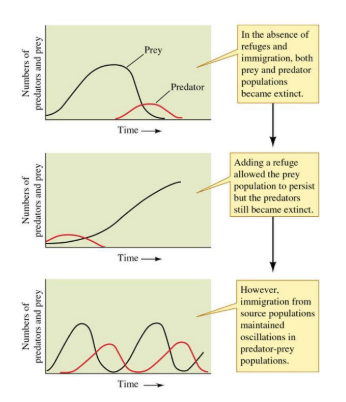
No refuge, no immigration:
Predators overhunt prey → prey go extinct → predators starve and also go extinct.
Both die.
Refuge only (no immigration):
Prey survive by hiding in refuges.
Predators go extinct because they can't find enough prey.
Prey live, predators die.
Refuge + immigration:
Prey survive in refuges, and predators starve
Immigration replenishes predators, creating stable cycles.
Both survive and cycle.
How are periodical cicadas and oak masting examples of predator satiation and temporal refuges?
Periodical cicadas (predator satiation):
Cicadas emerge in massive numbers once every 13 or 17 years.
This overwhelming quantity saturates predators’ ability to eat them, ensuring some cicadas survive.
Temporal refuge: Their synchronized, large emergence occurs at a set time, offering protection from predators due to sheer numbers.
Oak masting (predator satiation):
Oaks produce an unusually large number of acorns in some years (mast years).
Predators (like squirrels, deer) cannot consume all the acorns before they spoil or rot.
Temporal refuge: The timing of acorn production, combined with an abundance of food, prevents predators from consuming all of it, giving some a chance to survive.
What is the difference between community composition and community structure?
Composition = Which species are present in a community.
→ Example: oak trees, deer, squirrels, hawks.Structure = How species interact (direct and indirect interactions like predation, competition, mutualism).
→ Example: hawks prey on squirrels, deer compete with rabbits for grass.
What is the difference between direct and indirect effects in ecology?
Direct effects: Immediate interactions between two species (e.g., hawk eats vole = direct predation).
Indirect effects: Effects mediated through another species (trophic cascade and apparent competition).
What is a trophic cascade? Give an example from lecture.
A trophic cascade is a type of indirect effect where predators kick off a chain reaction that helps plants or lower species.
Example: Otters chow down on sea urchins → fewer urchins → kelp forests explode with life.
What is apparent competition? (Example from lecture.)
Apparent competition is a type of indirect effect where it looks like species are competing, but really, they’re both just getting wrecked by the same predator.
Example: Feral pigs are eaten by eagles → eagle population spikes → eagles also start eating island foxes — even though pigs and foxes don’t actually compete.
Name the 3 stages that influence community assembly and give examples
Dispersal: Can species even get to the habitat?
➔ Example: Seeds carried by wind over a mountain.Environmental filters: Can species survive the abiotic conditions?
➔ Example: Only drought-tolerant plants survive in a desert.Biotic filters: Can species deal with other species (like competition, predation, mutualism)?
➔ Example: A plant survives abiotic conditions but gets eaten by herbivores and disappears.
In the neutral model of community structure, how important are environmental and biotic filters?
Environmental filters:
→ Important. Species must survive abiotic conditions (like temperature, soil, sunlight).Biotic filters:
→ Not important. In the neutral model, species are "ecological clones," so competition and predation don't change who survives — randomness rules.Overall:
→ Community assembly is mostly random after dispersal and environmental filtering.
→ Who gets there and survives the environment matters — not who competes best.
In the niche-based model of community structure, how important are environmental and biotic filters?
Environmental filters: Important — species must survive abiotic stresses.
Biotic filters: Very important — species interactions (competition, facilitation, predation) shape who coexists.
Assembly: Non-random, sorted by both abiotic and biotic factors (niches).
Key difference between neutral and niche-based models of community assembly?
Neutral model: Random after environmental filtering — biotic interactions don’t matter much.
Niche-based model: Shaped by both environmental and biotic filters — species interactions structure the community.
How do coevolutionary relationships (biotic filters) influence community structure? (competition, facilitation, predation)
Biotic filters like competition, facilitation, and predation sort species after environmental filtering.
They shape who survives, who coexists, and how diverse a community is.
Outcome examples:
➔ Competition can reduce diversity or sort species into different niches.
➔ Facilitation can boost survival by making habitats more livable.
➔ Predation can prevent any one species from dominating, keeping diversity high (predators usually target the most abundant or easiest prey, which often are dominants — but not always, so predation can either maintain or reduce diversity depending on who they eat).
How can predation mediate community structure? Give examples.
Predators can maintain species diversity by preventing dominant species from taking over (predator-mediated coexistence).
Example 1: Sea stars eat dominant mussels → other species can survive on rocks.
Example 2: Apparent competition — pigs increase eagle numbers → eagles kill island foxes → indirect negative effect.
How can facilitation mediate community structure? Give an example.
Facilitation happens when one species helps another survive by making the environment easier.
Example:
➔ Kelp forests (foundation species) create shelter, reduce wave stress, and allow 1,000+ species to survive — they build habitat that benefits the whole community.
How can competition mediate community structure? Define and give examples.
Competition sorts species by who uses resources better. It can reduce diversity (strong competitors win) or maintain it (through networked competition).
Linear hierarchy:
➔ Species ranked top to bottom (A > B > C) one species dominates (low diversity).Competitive networks:
➔ No clear winner — "rock-paper-scissors" loop no one species is unbeatable (high diversity).Example:
➔ Coral species compete in loops, maintaining coral reef diversity.
What are keystone species and how are they different from dominants?
Keystone species:
➔ Have a huge impact on community structure despite low abundance.Dominant species:
➔ Have a big impact because they are very abundant or large (like foundation species).Key difference: Keystone species = high impact, low abundance; Dominants = high impact, high abundance.
Explain Paine’s classic Keystone Predator experiment.
Robert Paine removed sea stars (keystone predators) from tide pools.
Result:
➔ Mussels (a competitive dominant) took over, excluding other species.
➔ Species diversity crashed — only a few species survived.Conclusion: Sea stars prevented mussels from monopolizing space and maintained community diversity.
What mechanisms allow Keystone Predators to maintain diversity?
Compensatory mortality:
➔ Keystone predators preferentially target dominant competitors, killing enough of them to give weaker species a chance to survive.Mechanism:
➔ Predators reduce pressure from dominant species → open space and resources → more species coexist.
What is a keystone exotic? Give an example.
Keystone exotic: A non-native species that has a huge impact on community structure, like a keystone species, but it’s introduced (bad keystone).
Example:
➔ Golden eagles on Santa Cruz Islands — came because of feral pigs, then hunted island foxes, crashing fox populations and reshaping the ecosystem.
Define disturbance (Sousa’s Definition) and explain how it can vary with spatial and temporal scales
Disturbance:
➔ A discrete, punctuated event (like killing, damaging, or displacing individuals) that creates an opportunity for new individuals to establish.Spatial scale:
➔ Can range from small (like a fallen tree gap) to huge (like a glacier retreating).Temporal scale:
➔ Can happen rarely (like a 100-year flood) or frequently (like seasonal fires).
➔ Some disturbances are quick and sudden (like a hurricane) while others are slow (like drought stress over years).
Explain the 3 factors that define the nature of a disturbance. (Give examples.)
1) Intensity:
➔ How strong/severe the disturbance is.
➔ Example: A small fire vs. a massive wildfire that kills everything.
2) Extent (Size):
➔ How much physical space the disturbance covers.
➔ Example: A single fallen tree (small gap) vs. an entire forest blown down by a hurricane.
3) Frequency:
➔ How often the disturbance happens over time.
➔ Example: Rare "100-year floods" vs. frequent seasonal fires in grasslands.
Contrast Primary vs Secondary Succession
Primary succession:
➔ Starts on bare, abiotic surfaces with no soil.
➔ Follows extreme disturbances like glaciers retreating or volcanic eruptions.
➔ Pioneer species (like mosses and lichens) colonize first.
Secondary succession:
➔ Happens where soil and some life remain after disturbance.
➔ Follows fires, farming, logging — not a total wipeout.
➔ Plants regrow faster because conditions are less harsh.
Explain plant community changes for old field succession and sand dune succession (Lake Michigan).
Old field succession (secondary succession):
Starts with grasses and weeds (pioneer species).
Then shrubs move in.
Finally trees establish, leading to a forest over time.
Faster
Sand dune succession (primary succession at Lake Michigan):
Bare sand is first colonized by grasses (like beach grasses).
Then shrubs and small trees grow.
Eventually leads to a full forest (with oaks, maples) far from the shoreline.
Slower
Old fields already have soil, so plants regrow fast; sand dunes start bare and need grasses to build soil before a forest can form.
What are the elements of Clementsian succession?
Succession is predictable and orderly.
Species modify the environment (autogenic change) to help later species.
Leads to a stable, climate-driven climax community.
Disturbance is rare — stability is the natural state.
Succession follows regular seral stages (pioneer → intermediate → climax).
What is the Gleasonian paradigm?
Succession is random and individualistic.
Chance events (dispersal, survival) and species' tolerances drive community assembly.
Disturbance is common — constant change is normal.
No fixed climax — different communities can form even under similar conditions.
What is the key difference between Clementsian and Gleasonian views of succession?
Clements:
Succession is predictable, orderly, and leads to a stable climax community.
Disturbance is rare; stability is the norm.
Gleason:
Succession is random, individualistic, and communities constantly change based on chance.
Disturbance is common; stability is rare.
What are critiques of Clementsian succession?
Disturbances are common, not rare — nature isn’t always stable.
Chance and randomness (dispersal, survival) play bigger roles than Clements thought.
Communities aren't always predictable — multiple outcomes are possible, not just one climax.
Patch dynamics: Real ecosystems are mosaics of patches at different stages of succession, not uniform.
What is diversity? Why is it valuable? What are challenges in measuring it?
Diversity = species richness + species evenness.
Value: resilience, ecosystem function, ethics, adaptation.
Challenges: depends on scale, incomplete sampling, definitions vary, shifting human baselines.
What are alpha, beta, and gamma diversity?
Alpha diversity: species richness within one community.
Beta diversity: difference in species between nearby communities.
Gamma diversity: total diversity across a landscape (many communities combined).
How do you interpret rank-abundance curves?
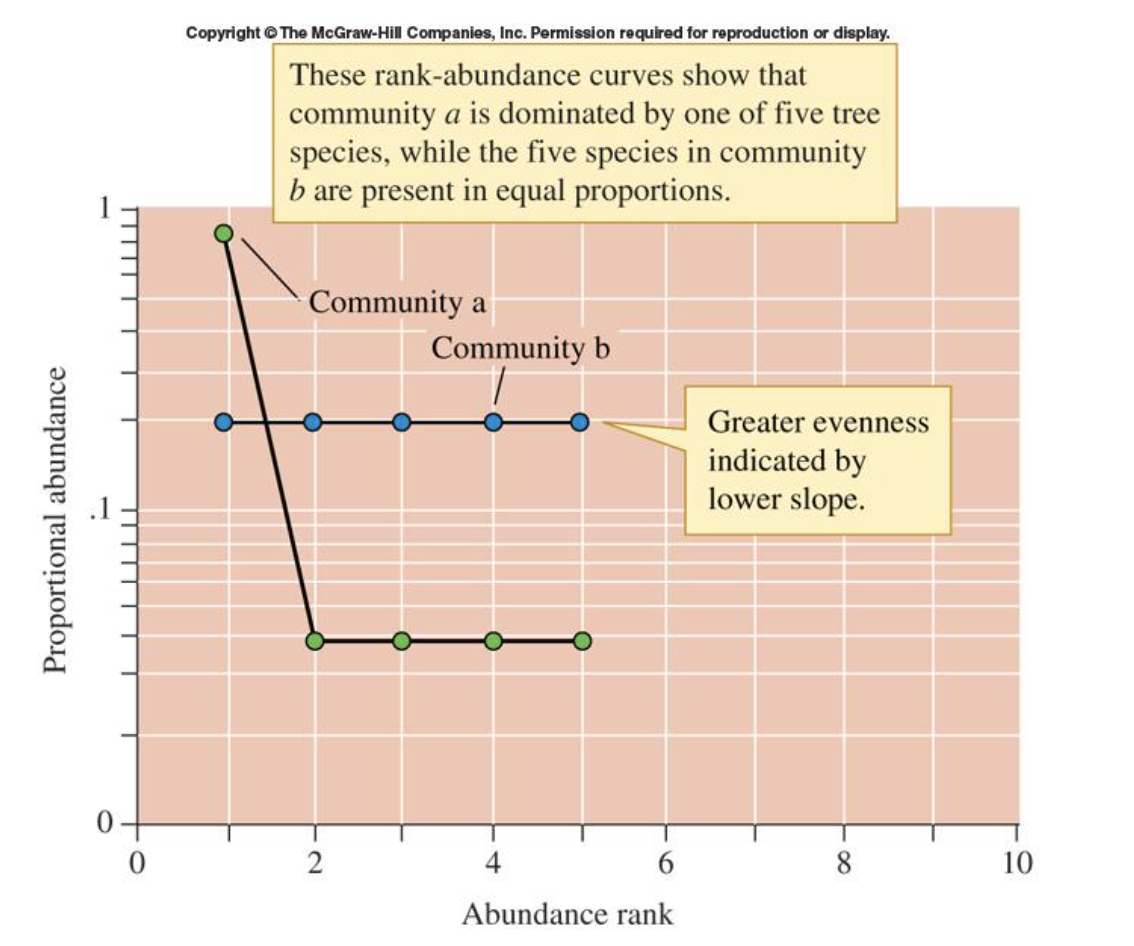
X-axis: Species rank (from most to least abundant).
Y-axis: Relative abundance (proportion of individuals).
Key points:
Flatter slope = greater evenness (species are similarly abundant).
Steeper slope = lower evenness (few species dominate, others rare).
Length of curve = species richness (longer = more species).
What’s the difference between species richness and evenness?
Richness = number of species.
Evenness = how evenly individuals are distributed among species.
Both matter: together they determine true biodiversity and ecosystem function.
What does the Shannon-Wiener Index (H′) measure and how?
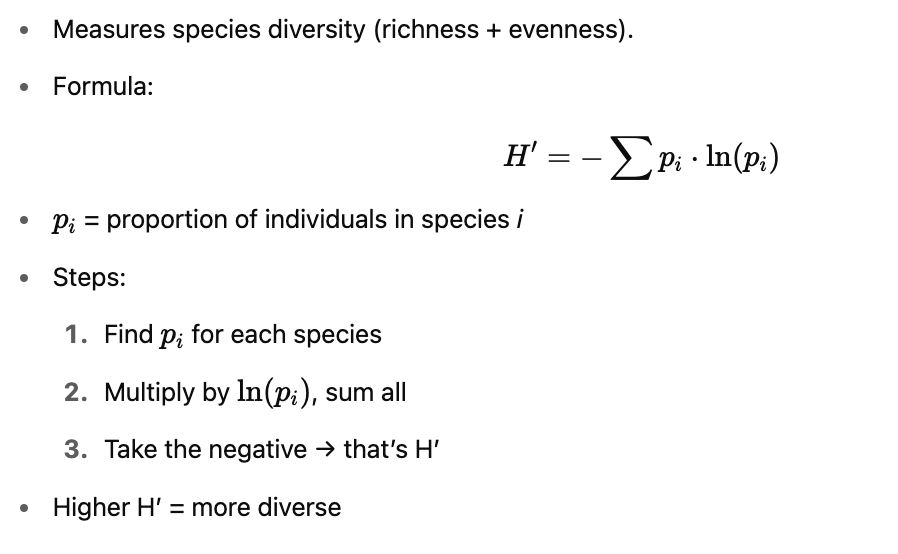
What is the Intermediate Disturbance Hypothesis (IDH)? (Non-equilibrium)
A little chaos is good!
If there’s some disturbance (but not too much), no species can take over, so lots survive.
Example: Fires keep tallgrass prairies diverse; no fire = trees take over.
What is the Red Queen Hypothesis? (Non-equilibrium, biotic)
"Run just to stay in place!" (Alice in Wonderland)
Species have to keep evolving to survive against predators, diseases, and competitors.
Example: Rabbits get faster, foxes get faster too.
What is the Court Jester Hypothesis? (Non-equilibrium, abiotic)
The environment tells the joke
Nature throws wild, random events — like meteor strikes or ice ages — that shake up ecosystems.
Survival isn't just about competition; it’s also about luck sometimes!
Example: Dinosaurs wiped out by an asteroid.
What’s the Lottery Model?
It’s like musical chairs — first species to land gets the spot.
It's not about who's best, just who shows up first.
Example: Barnacles grabbing space on a rock.
What’s Island Biogeography Theory (IBT)?
Bigger islands = more room = more species.
Closer islands = easier for species to get there = more species.
It’s all about balancing new arrivals vs. extinctions.
Example: More bird species on big, near islands.
What’s the Environmental Complexity Hypothesis?
More habitats = more ways to live.
Complex environments (like coral reefs or patchy soils) support lots of different species because everyone can find a niche.
Example: More plant species where soils vary a lot.
What happens to species richness at low disturbance levels (IDH)?
Competition dominates.
A few species outcompete others → low diversity.
What happens to species richness at high disturbance levels (IDH)?
Only disturbance-tolerant species survive.
Many species are wiped out → low diversity.
Why is species richness highest at intermediate disturbance levels (IDH)?
Balance between competition and disturbance.
Space opens before domination happens → most species can coexist.
Where is competition highest vs. disturbance tolerance highest on the IDH curve?
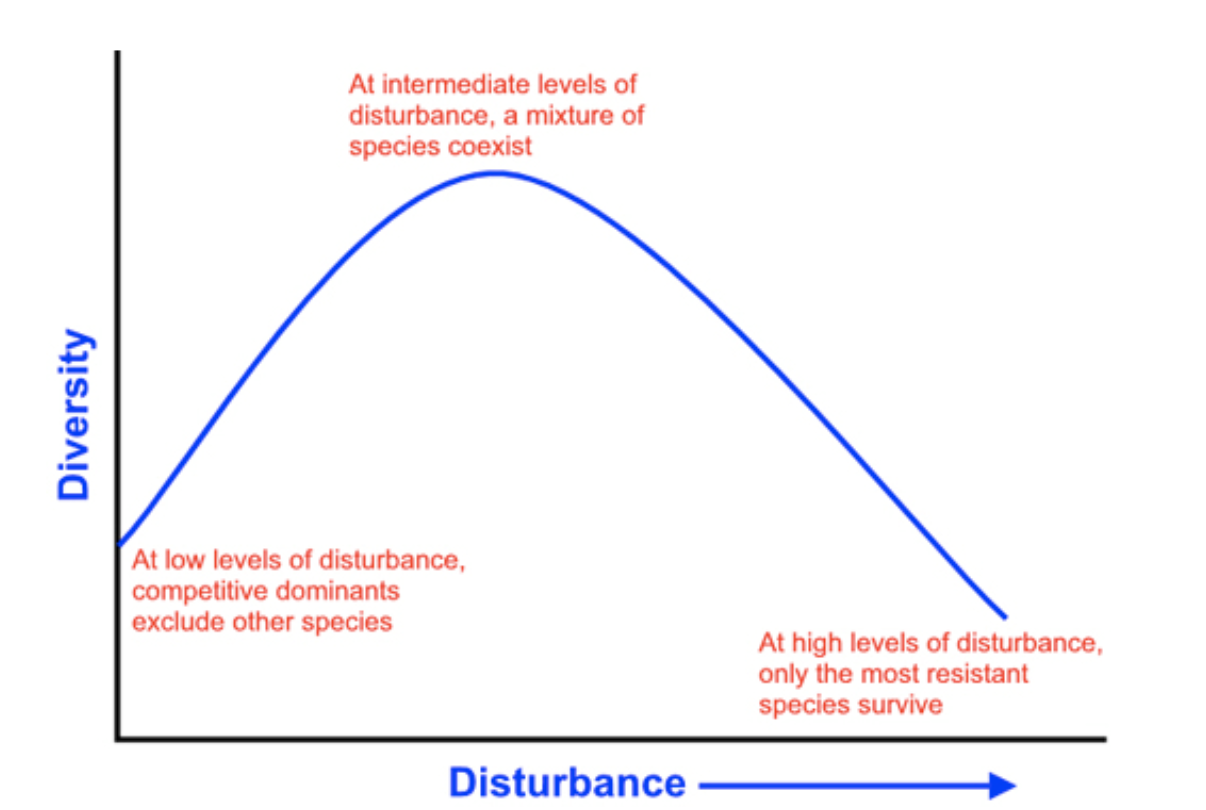
Competition high = low disturbance (left side).
Disturbance tolerance high = high disturbance (right side).
Bell curve–diversity is highest when disturbance is moderate, as there will be not be much competition, but the disturbance is not extreme
Give experimental examples supporting IDH
Coral reefs: Moderate storms keep reefs diverse.
Prairies: Regular fires prevent tree takeover; maximize grass diversity.
What does IDH suggest about restoring prairies?
Active disturbance (like fire) is needed.
Without it, diversity drops and forests take over.
What controls species richness in Island Biogeography Theory (IBT)?
Immigration and extinction rates.
Large, near islands = highest stable species richness (SR).
Immigration falls as niches fill; extinction rises with crowding.
What shapes immigration and extinction curves in IBT?
Immigration: High when few species, drops as island fills.
Extinction: Low when few species, rises with competition and limited resources.
What is the evidence for (Simberloff and Wilson) and critique of IBT?
Support:
Simberloff & Wilson (1969):
They fumigated small mangrove islands (killed all insects).
Result:
Species richness bounced back to a predictable number based on island size and distance from the mainland.
Closer islands recovered faster than far ones.
Conclusion: Immigration and extinction drive species richness, just like IBT predicts.
Critiques:
Real-world "islands" (like forest patches) are not totally isolated — species can cross the "matrix" (the surrounding land).
Human activities change patch size, shape, and connectivity.
Species interactions (like competition and predation) also matter, not just immigration/extinction.
After a fire, what types of plants (in Grime’s triangle) are common, and what traits do they have?
Ruderal plants dominate after burning.
Traits:
Fast-growing
Early reproduction
Good seed dispersal
Short lifespan
Why: They quickly colonize open, disturbed space before competitors arrive.